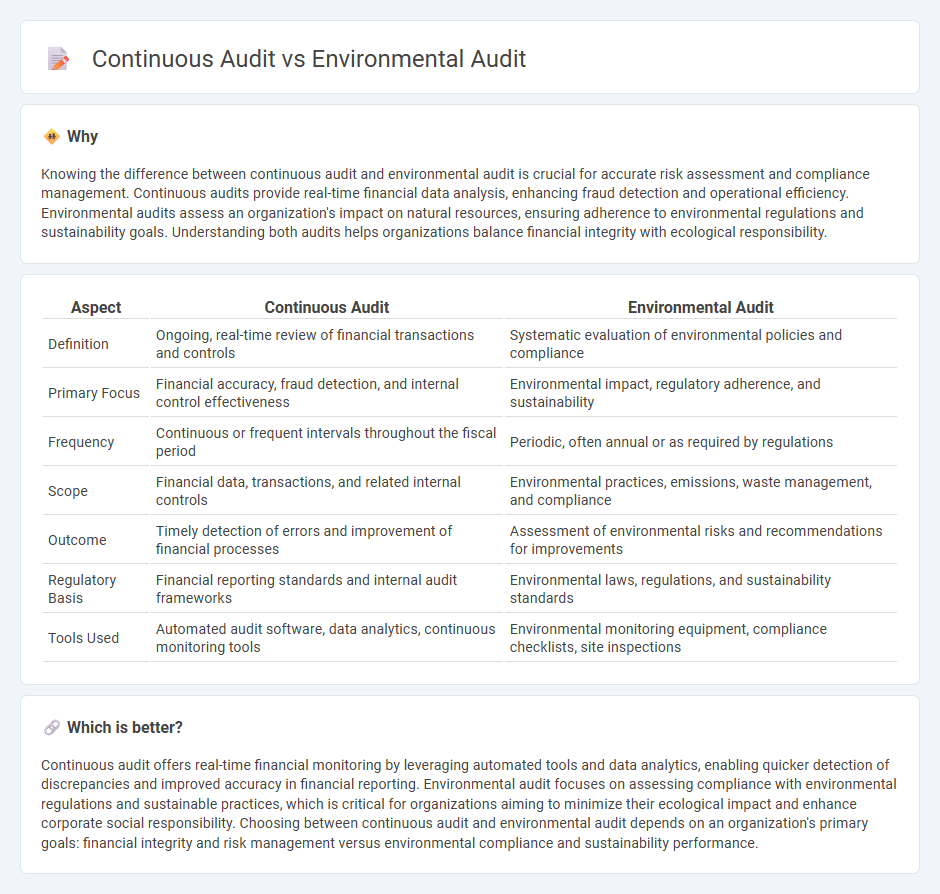
Continuous audit employs automated tools and real-time data analysis to provide ongoing assurance of financial transactions and internal controls. Environmental audit focuses on evaluating an organization's compliance with environmental laws and sustainability practices, assessing impacts on ecosystems and regulatory adherence. Explore in-depth differences and applications of continuous and environmental audits to enhance corporate accountability.
Why it is important
Knowing the difference between continuous audit and environmental audit is crucial for accurate risk assessment and compliance management. Continuous audits provide real-time financial data analysis, enhancing fraud detection and operational efficiency. Environmental audits assess an organization's impact on natural resources, ensuring adherence to environmental regulations and sustainability goals. Understanding both audits helps organizations balance financial integrity with ecological responsibility.
Comparison Table
| Aspect | Continuous Audit | Environmental Audit |
|---|---|---|
| Definition | Ongoing, real-time review of financial transactions and controls | Systematic evaluation of environmental policies and compliance |
| Primary Focus | Financial accuracy, fraud detection, and internal control effectiveness | Environmental impact, regulatory adherence, and sustainability |
| Frequency | Continuous or frequent intervals throughout the fiscal period | Periodic, often annual or as required by regulations |
| Scope | Financial data, transactions, and related internal controls | Environmental practices, emissions, waste management, and compliance |
| Outcome | Timely detection of errors and improvement of financial processes | Assessment of environmental risks and recommendations for improvements |
| Regulatory Basis | Financial reporting standards and internal audit frameworks | Environmental laws, regulations, and sustainability standards |
| Tools Used | Automated audit software, data analytics, continuous monitoring tools | Environmental monitoring equipment, compliance checklists, site inspections |
Which is better?
Continuous audit offers real-time financial monitoring by leveraging automated tools and data analytics, enabling quicker detection of discrepancies and improved accuracy in financial reporting. Environmental audit focuses on assessing compliance with environmental regulations and sustainable practices, which is critical for organizations aiming to minimize their ecological impact and enhance corporate social responsibility. Choosing between continuous audit and environmental audit depends on an organization's primary goals: financial integrity and risk management versus environmental compliance and sustainability performance.
Connection
Continuous audit leverages real-time data analysis to monitor financial transactions, ensuring accuracy and compliance in accounting practices. Environmental audit assesses a company's adherence to environmental regulations and sustainability standards, which increasingly impact financial reporting and risk management. Integrating continuous audit with environmental audit enhances transparency and accountability by continuously evaluating both financial and environmental performance.
Key Terms
**Environmental Audit:**
Environmental audits systematically assess a company's compliance with environmental regulations and the effectiveness of its sustainability practices, identifying areas for reducing pollution and resource consumption. This process involves site inspections, data review, and benchmarking against environmental standards such as ISO 14001 to ensure operational sustainability. Explore more about how environmental audits drive corporate responsibility and regulatory adherence.
Compliance
Environmental audits evaluate compliance with regulatory standards related to pollution control, waste management, and resource usage, ensuring organizations meet environmental laws and reduce ecological impact. Continuous audits provide real-time monitoring of compliance by integrating automated data collection and analysis, enabling organizations to detect and address non-compliance issues promptly. Explore how these audit approaches enhance regulatory adherence and environmental performance in your organization.
Sustainability
Environmental audits evaluate a company's compliance with environmental regulations and assess the impact of operations on ecosystems, emphasizing waste management, resource usage, and pollution control. Continuous audits leverage real-time data and technology to monitor sustainability metrics consistently, enabling proactive identification of environmental risks and opportunities for improvement. Explore more on how these audit types drive sustainable business practices and regulatory adherence.
Source and External Links
Environmental Audit and its Importance - This webpage discusses the core purpose and importance of environmental audits, focusing on their role in ensuring compliance with environmental regulations and identifying areas for improvement.
How to Prepare for and Conduct Environmental Audits - This article provides guidance on preparing for and conducting environmental audits, including the types of audits and their implications for compliance and certification.
Environmental Audit - This Wikipedia page defines environmental audits as evaluations that identify compliance and management system gaps, discussing their functions and types.
 dowidth.com
dowidth.com